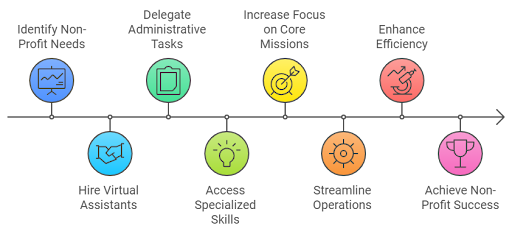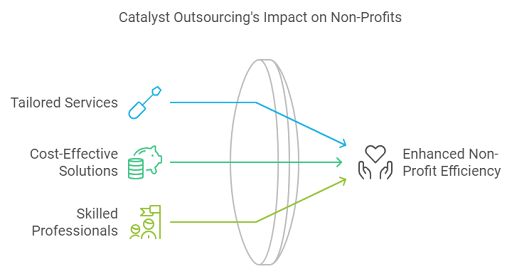
Non-profit organisations face a unique set of challenges, from limited resources to high operational demands. The need to maximise efficiency without compromising on impact is a constant balancing act. For many non-profits, virtual assistants (VAs) have become an invaluable resource, helping streamline operations, increase productivity, and expand outreach, all while keeping costs low.
In this blog, we’ll explore how virtual assistants can help nonprofits achieve their missions more effectively, the key tasks they can take on, and how Avery Outsourcing’s Virtual Assistant Services in Singapore can support non-profit organisations in scaling their impact.
The Role of Virtual Assistants in Non-Profit Organisations
Virtual assistants are remote professionals who provide administrative, technical, and creative assistance. For non-profits, they offer a flexible, cost-effective way to handle time-consuming tasks that might otherwise distract from core activities. Whether managing donor databases, handling social media, or coordinating volunteers, VAs enable non-profits to function more efficiently without the overhead of full-time staff.
The Cost-Efficiency of VAs in a Budget-Conscious Sector
Non-profit organisations often operate under tight budgets, where every dollar spent must yield significant impact. Hiring full-time employees can strain these budgets due to the costs associated with salaries, benefits, office space, and equipment. In contrast, VAs provide the same high-quality support at a fraction of the cost, as they work remotely and often on a part-time basis.
This allows non-profits to scale their efforts without the financial burden, freeing up resources to focus on their mission. By outsourcing administrative tasks to VAs, nonprofits can reduce overhead expenses and direct more funding toward program development and service delivery.
Essential Virtual Assistant Tasks for Charity Organizations
Nonprofits can leverage VAs for a wide variety of tasks. Here are some key areas where virtual assistants can make a significant impact:
1. Administrative and Office Management
For non-profits, day-to-day administrative tasks can quickly become overwhelming. VAs can handle essential office management duties such as scheduling, managing emails, organising documents, and preparing reports. This ensures that internal processes run smoothly, freeing up in-house staff to focus on more strategic initiatives.
Administrative efficiency is critical in ensuring that nonprofits stay organised and responsive to the needs of their community and donors. VAs can also help with database management, ensuring that all data is accurate, up-to-date, and easily accessible.
2. Fundraising and Donor Management
Fundraising is at the heart of any non-profit’s sustainability. VAs can assist with donor research, identifying potential contributors, and managing donor relationships through CRM systems. This enables non-profits to cultivate and maintain a robust donor base, even when internal resources are stretched thin.
VAs can also help in organising fundraising events, drafting donation request letters, and managing donor appreciation efforts. These tasks, when efficiently managed, can significantly increase a non-profit’s ability to raise funds and maintain strong donor relationships.
3. Social Media and Online Presence
In today’s digital age, having an active online presence is crucial for non-profits. Social media platforms provide an opportunity to engage with supporters, share success stories, and raise awareness about causes. However, maintaining these platforms can be time-consuming.
VAs can manage social media accounts by creating content, scheduling posts, and responding to comments. They can also monitor social media performance, track engagement metrics, and optimise posts to increase visibility. By keeping social media activity consistent and engaging, nonprofits can expand their reach and build a more substantial online community.
4. Volunteer Coordination
Volunteer management is often a complex and resource-intensive task. Nonprofits rely heavily on volunteers to execute their programs, but coordinating large groups of people can be overwhelming. VAs can assist with recruiting, onboarding, and scheduling volunteers, ensuring that every event or program has the necessary support.
Furthermore, VAs can maintain communication with volunteers, providing updates, answering questions, and keeping them engaged. By streamlining volunteer coordination, nonprofits can improve their operational efficiency and deliver services more effectively.
5. Financial and Grant Management
Nonprofits must maintain accurate financial records and ensure compliance with donor requirements and legal regulations. VAs can assist with tracking expenses, preparing financial reports, and managing grants. This ensures transparency and accountability, which are critical for maintaining donor trust and securing future funding.
VAs can also help with the preparation of grant applications, conducting research, and tracking deadlines. By delegating these tasks to a VA, nonprofits can focus on program implementation without worrying about the administrative burden of financial management.
6. Event Planning and Execution
Events are a crucial part of non-profit operations, whether it’s a fundraising gala, a community outreach program, or an awareness campaign. Planning these events requires attention to detail and significant organisational effort. VAs can take on tasks such as managing RSVPs, sending out invitations, and coordinating logistics.
In the digital era, virtual events are becoming more popular, and VAs can assist in setting up webinars, managing online registrations, and handling post-event follow-ups. With the support of a VA, nonprofits can execute successful events that enhance their visibility and impact.
Benefits of Virtual Assistants in the Non-Profit Sector

The benefits of employing virtual assistants in non-profit organisations are vast, ranging from increased flexibility to better use of resources.
1. Flexibility and Scalability
One of the most significant advantages of VAs is the flexibility they offer. Nonprofits can scale up or down their use of VAs depending on their current needs, without the long-term commitment of hiring full-time staff. This flexibility allows non-profits to respond quickly to changes in demand or funding availability.
For example, during peak fundraising seasons or when launching a new campaign, a non-profit can bring on additional VAs to manage the increased workload. Once the campaign is over, they can scale back without having to deal with layoffs or excess payroll costs.
2. Access to Specialised Skills
Many non-profits require specialised skills that may not be available within their current team. For instance, a small non-profit might need expertise in graphic design, digital marketing, or grant writing. Hiring full-time staff for these roles can be expensive and unnecessary for occasional needs.
VAs, on the other hand, can offer these specialised services on a project-by-project basis, allowing non-profits to access the skills they need without long-term commitments. This enables non-profits to produce high-quality work without stretching their budget.
3. Increased Focus on Core Missions
When non-profits delegate administrative tasks to VAs, they free up time for their internal team to focus on mission-critical activities. Staff can devote more energy to strategic planning, program development, and community engagement rather than getting bogged down in paperwork and routine tasks.
By streamlining their operations with the help of VAs, nonprofits can operate more efficiently and dedicate their efforts to making a meaningful impact on the communities they serve.
4. Enhanced Operational Efficiency
VAs provide non-profits with a way to streamline operations and reduce inefficiencies. By delegating time-consuming tasks like data entry, email management, and financial tracking, nonprofits can operate more smoothly. This enhanced efficiency translates into better service delivery and increased capacity to handle new projects.
VAs also bring expertise in tools and platforms that can automate or simplify tasks, such as CRM systems, social media management tools, and cloud storage solutions. By leveraging technology, nonprofits can further improve their operational efficiency and reduce the manual effort required to manage their day-to-day activities.
How to Effectively Integrate Virtual Assistants into Your Non-Profit Workflow
For non-profits looking to integrate VAs into their workflow, it’s essential to have a clear plan in place to ensure a smooth transition and maximise the benefits of remote support.
1. Conducting a Needs Assessment
The first step in integrating VAs into your non-profit is to conduct a thorough needs assessment. Identify the tasks that are taking up the most time for your in-house staff and evaluate which of these tasks can be delegated to a VA. This could include administrative duties, donor management, social media, or event planning.
By pinpointing the areas where you need the most support, you can create a clear outline of the tasks a VA will handle and ensure that they align with your organisation’s goals.
2. Setting Clear Expectations and KPIs
Once you’ve identified the tasks a VA will handle, it’s essential to set clear expectations and key performance indicators (KPIs). This helps ensure that both your team and the VA are on the same page and working toward the same objectives.
Provide your VA with detailed instructions, deadlines, and the necessary tools to complete their tasks efficiently. Setting up regular check-ins and performance reviews will help you monitor progress and make adjustments as needed.
3. Using Collaboration Tools Effectively
To effectively manage a virtual team, it’s essential to use the right collaboration tools. Platforms like Slack, Asana, and Trello make it easy to communicate, assign tasks, and track progress in real-time. These tools also enable your team to stay connected with your VA, ensuring that everyone is on the same page and that tasks are completed efficiently.
Additionally, cloud-based storage solutions like Google Drive and Dropbox allow VAs to access documents and files from anywhere, ensuring seamless collaboration across teams.
Challenges and Solutions in Managing Virtual Assistants
While VAs can provide significant benefits, managing a remote workforce comes with its own set of challenges. Here are some common challenges and solutions:
1. Communication Barriers
Working remotely can sometimes lead to miscommunication or a lack of clarity. To overcome this, establish clear communication channels with your VAs. Schedule regular check-ins and use project management tools to ensure that everyone is on the same page. It’s also important to set expectations for response times and availability.
2. Security and Data Protection
Non-profits often handle sensitive information, such as donor data and financial records. When working with VAs, it’s crucial to have security measures in place to protect this data. Use encrypted communication tools, limit access to sensitive documents, and require VAs to sign confidentiality agreements.
Additionally, ensure that your VA is familiar with data protection regulations and best practices to avoid any breaches or mishandling of information.
3. Maintaining Team Cohesion
When team members are working remotely, it can be challenging to maintain a sense of cohesion and collaboration. To address this, make an effort to include your VAs in team meetings and decision-making processes. Encourage open communication and foster a culture of inclusion, so that VAs feel like an integral part of the team.
Regularly recognize and celebrate the contributions of your VAs to keep morale high and ensure that they remain engaged with your organisation’s mission.
Why Virtual Assistants Are a Game-Changer for Non-Profits During Economic Downturns
Economic downturns pose significant challenges for nonprofits, with reduced donations and increased demand for services. In these circumstances, VAs can help nonprofits stay afloat by offering a flexible, cost-effective solution for maintaining operations.
VAs allow nonprofits to continue delivering essential services without the financial burden of hiring full-time staff. During economic downturns, this can be a lifeline, enabling organisations to scale back on in-house staff while still maintaining productivity.
Furthermore, VAs can help nonprofits identify new funding opportunities by assisting with grant applications, research, and outreach efforts. By leveraging the expertise of VAs, nonprofits can adapt to economic challenges and continue making a meaningful impact.
Spotlight: Avery Outsourcing – Virtual Assistant Services in Singapore
Avery Outsourcing is a leading provider of virtual assistant services, offering tailored solutions for non-profit organisations in Singapore. With a team of highly skilled VAs, Avery Outsourcing helps non-profits streamline operations, enhance productivity, and achieve their goals more efficiently.

1. Tailored VA Services for the Charity Sector
Avery Outsourcing understands the unique challenges faced by non-profits and offers specialised services to meet their needs. Whether it’s managing donor databases, handling social media, or coordinating events, Avery Outsourcing provides expert support that enables non-profits to operate more effectively.
2. Cost-Effective Solutions for Small and Large Nonprofits
Avery Outsourcing offers flexible pricing options that make their services accessible to non-profits of all sizes. Whether you’re a small organisation with limited resources or a larger non-profit looking to scale, Avery Outsourcing can provide the support you need at an affordable cost.
3. Skilled, Professional Assistants
All of Avery Outsourcing’s virtual assistants are highly trained professionals with extensive experience in the non-profit sector. Their expertise ensures that nonprofits receive top-quality support, allowing them to focus on their core mission without worrying about administrative tasks.
4. Why Nonprofits Choose Avery Outsourcing
Nonprofits choose Avery Outsourcing because of their commitment to providing high-quality, reliable virtual assistant services. With a proven track record of success, Avery Outsourcing is the trusted partner for non-profits looking to enhance their operations and achieve greater impact.
Real-World Example of VA Success in Non-Profits
The impact of virtual assistants in non-profits is not just theoretical; many organisations have already experienced measurable benefits. Let’s look at a real-world example of how a non-profit organisation successfully integrated virtual assistants into its operations.
Case Study: Hope for All – Enhancing Fundraising with Virtual Assistance
Hope for All, a non-profit dedicated to providing food and shelter to homeless families, was facing significant challenges in maintaining donor relationships and organising fundraising events. With a small in-house team, managing day-to-day operations and simultaneously focusing on fundraising became overwhelming.
The Challenge: Lack of Resources for Donor Engagement
The organisation found that many of its recurring donors were not being adequately followed up with, leading to a decline in donations. Additionally, the planning of its annual fundraising gala was behind schedule, putting the event’s success at risk. With limited staff and a growing list of tasks, Hope for All was struggling to keep up.
The Solution: Hiring a Virtual Assistant
The organisation turned to virtual assistants to alleviate the burden. They hired a VA specifically to manage donor relationships and help coordinate the upcoming fundraising event. The VA took on several critical tasks, including:
- Donor Management: Updating donor information in the CRM, sending thank-you emails, and creating a system for regular donor follow-ups.
- Event Coordination: Managing guest lists, sending invitations, coordinating with vendors, and tracking RSVPs for the fundraising gala.
The Results: Increased Donor Retention and Successful Event
With the support of a VA, Hope for All saw a 20% increase in donor retention within six months. Regular follow-ups and a more organised approach to donor management helped keep existing donors engaged, while new systems for tracking communication improved overall donor satisfaction.
The VA also played a key role in the success of the fundraising gala, which exceeded its original fundraising goal by 30%. By delegating event planning tasks to a VA, the in-house team was able to focus on attracting high-profile sponsors and preparing impactful presentations for the gala.
This case study illustrates how even small nonprofits can benefit from virtual assistants, significantly boosting their operational efficiency and ability to achieve their mission.
Exploring Global Trends in Virtual Assistance for Non-Profits

As the world continues to evolve, so does the role of virtual assistants. Nonprofits are increasingly adopting new technologies and innovative approaches to streamline their operations, and VAs are at the forefront of these changes. Let’s explore some of the emerging trends in virtual assistance for non-profits.
1. Automation and AI-Driven Tasks
Automation is revolutionising the way nonprofits manage their workflows, and virtual assistants are integrating automation tools to further enhance efficiency. With AI-driven tools, VAs can automate repetitive tasks like data entry, email sorting, and social media scheduling. This allows non-profits to reduce human error, speed up processes, and free up more time for core activities.
For example, AI chatbots integrated into websites can handle basic donor inquiries or event registrations without the need for manual intervention. Similarly, automated email campaigns can nurture donor relationships, sending personalised messages based on donor behaviour.
By combining automation with the personal touch of a VA, nonprofits can optimise their operations while maintaining a high level of engagement with their community.
2. Global Talent Sourcing
The rise of remote work has opened up a global pool of talent for non-profits. Today, nonprofits are no longer limited to hiring locally; they can tap into skilled virtual assistants from all over the world. This global talent pool allows non-profits to find specialised skills that may be scarce or too expensive in their local market.
For example, a non-profit in Singapore might hire a graphic design VA from the Philippines, a grant writing VA from the United States, and a social media VA from India. By outsourcing specific tasks to professionals in different regions, nonprofits can access top-tier expertise at a fraction of the cost.
3. Enhanced Collaboration Through Remote Tools
As nonprofits become more comfortable with remote work, they are also embracing tools that enhance collaboration across teams and with VAs. Platforms like Zoom, Microsoft Teams, and Slack have become essential for virtual meetings and day-to-day communication.
In addition, task management platforms such as Asana, Trello, and Monday.com help non-profits keep track of projects and deadlines, ensuring that everyone—whether in-house or remote—stays aligned with the organisation’s goals.
These tools also allow for real-time collaboration, enabling VAs to work seamlessly with in-house teams, regardless of their physical location.
4. Focus on Sustainability and Long-Term Partnerships
Another emerging trend is the shift towards building long-term partnerships with virtual assistants. Rather than hiring VAs on a short-term or project-based basis, nonprofits are increasingly integrating VAs into their long-term strategic plans.
By fostering long-term relationships with VAs, nonprofits can benefit from greater continuity, reduced training time, and a deeper understanding of the organisation’s mission. VAs who are familiar with the inner workings of a non-profit can provide more tailored support, allowing the organisation to operate more efficiently over time.
This trend also promotes a sense of loyalty and engagement from the VA, as they become more invested in the success of the organisation.
Addressing Common Concerns About Working with Virtual Assistants
While the benefits of hiring virtual assistants are clear, many nonprofits have concerns about how to manage remote workers. Below, we address some of the most common concerns nonprofits face when integrating VAs into their operations.
1. How Can We Ensure Accountability?
One of the primary concerns nonprofits have about hiring virtual assistants is accountability. Without the ability to physically monitor VAs, how can nonprofits ensure that work is being completed on time and to a high standard?
The solution lies in setting clear expectations and utilising project management tools. By establishing detailed work plans, deadlines, and key performance indicators (KPIs), non-profits can ensure that VAs understand their responsibilities. Regular check-ins via video calls and progress reports also help to maintain transparency and accountability.
Project management tools like Asana or Trello can be used to assign tasks, track progress, and set deadlines, ensuring that everyone is aligned with organisational objectives.
2. How Do We Maintain Data Security?
Data security is a significant concern for non-profits, especially when handling sensitive information like donor details and financial records. Fortunately, there are several steps non-profits can take to ensure that data remains secure when working with virtual assistants.
First, it’s important to provide VAs with access only to the information they need to complete their tasks. Using password management tools like LastPass can ensure that sensitive login details are protected. Additionally, cloud storage platforms like Google Drive or Dropbox offer secure sharing and can limit access based on user roles.
Lastly, nonprofits should consider requiring VAs to sign non-disclosure agreements (NDAs) to legally protect confidential information.
3. What If There Are Communication Barriers?
Working with a virtual assistant who is based in a different country can sometimes lead to communication challenges, especially if there are time zone differences or language barriers. To address this concern, it’s essential to establish clear communication protocols from the outset.
Tools like Slack or Zoom can facilitate real-time communication, while project management software can ensure that all task-related information is documented and easy to track. It’s also a good idea to schedule regular check-ins and provide detailed instructions for each task to avoid any misunderstandings.
In terms of time zone differences, nonprofits can find virtual assistants who work in overlapping time zones or can adjust their working hours to ensure effective collaboration.
Let Avery Outsourcing Elevate Your Nonprofit’s Success
Don’t let administrative tasks slow you down. Avery Outsourcing offers expert virtual assistant services designed to help non-profits operate more efficiently and effectively. Whether you need support with donor management, event planning, or financial tracking, Avery Outsourcing’s skilled team is here to help.
Contact Avery Outsourcing today for a free consultation and learn how we can help your non-profit maximise its impact. Visit Avery Outsourcing or text us at +65 8914 9835 to get started!




